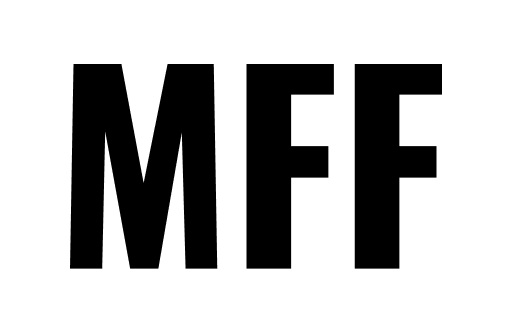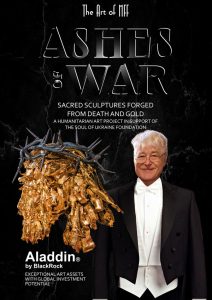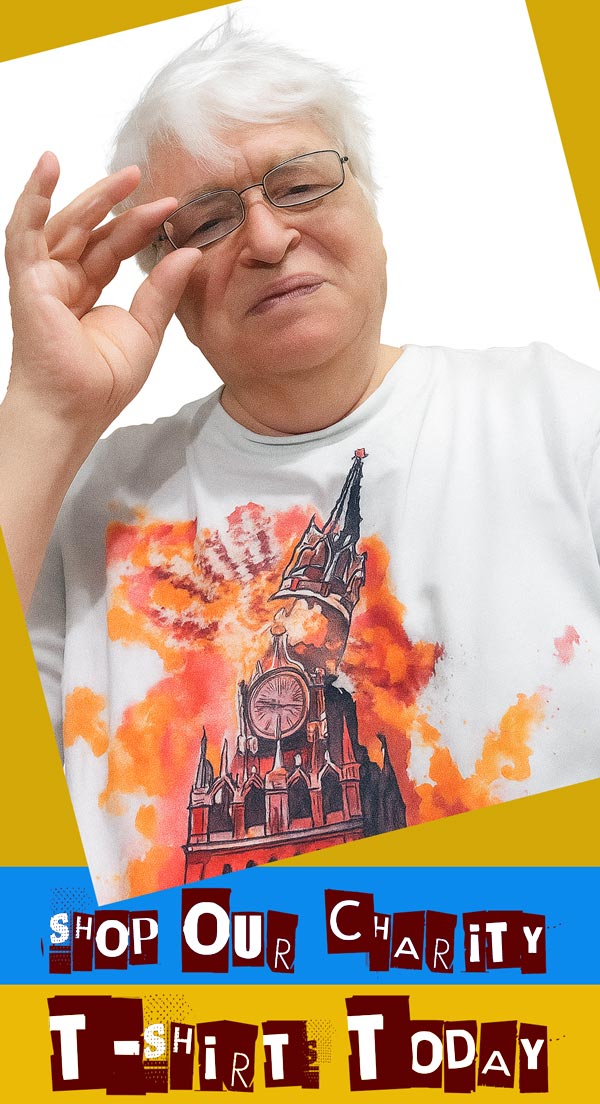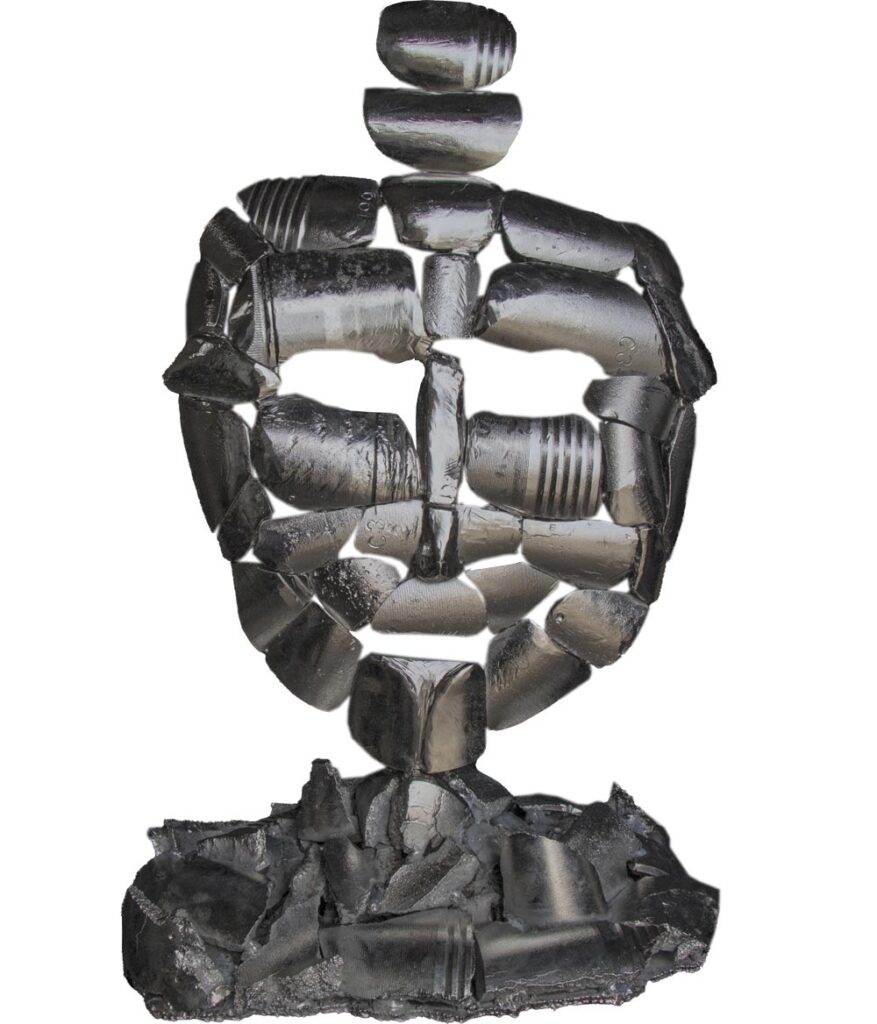
The Art of MFF | Mask of The War God by Sergey Melnikoff & Viktor Bielchyk.
Photo by Mariia Universaliuk
Details
MASK OF THE WAR GOD
This metal replica of the mask of Itzam Kokaj Bahlam was crafted by metal specialist Viktor Bielchyk, who brought to life the vision of artist Sergey Melnikoff. The Ukrainian artisan cut large fragments of combat mines and meticulously assembled dozens of metal elements to replicate the jade design of the mask worn by one of the Maya rulers from the Chochkitam province.
The mask is mounted on a base constructed from a chaotic heap of shrapnel, also sourced from combat mines.
Dimensions: 63 х 43 | 25 x 17 in
Gross Weight: ~25 kg
Provenance
The Author: Sergey Melnikoff (MFF) in collaboration with Ukrainian welder Viktor Bielchyk.
This work of art was created in Odesa, Ukraine, in 2024, during a critical phase of the Russian-Ukrainian war.
Seller: The Soul of Ukraine Foundation, Inc. — a U.S.-based charitable public corporation registered under section 501(c)(3) of the Internal Revenue Code.
A 501(c)(3) tax-deductibility certificate is issued to the purchaser, allowing the full amount expended to be written off for U.S. federal tax purposes.
Mask of The War God
Itzam Kokaj Bahlam
Ancient Origins: The Jade Mask of a Maya King
In 2021, archaeologists exploring the pyramid at Chochkitam in Guatemala’s Petén region made a breathtaking discovery. Inside the pyramid’s inner chamber—despite evidence of looting—they found an intricately assembled jade mosaic mask. Inscribed hieroglyphs on accompanying bone fragments identified the buried ruler as Itzam Kokaj Bahlam, a Maya king who likely reigned around 350 C.E., during the Classic Maya period.
Further analysis revealed carvings depicting the king holding the head of a deity known as Yax Wayaab Chahk G1, the “first sorcerer rain god” or Chahk—a powerful storm deity. The mask’s form mirrored the figure carved on the bones, reinforcing its religious and ceremonial significance.
This extraordinary find reveals much about Maya beliefs: jade—a material they revered for its protective and spiritual essence—was reserved for elite funerary rituals and divine imagery . The discovery also hints at a broader political landscape: Chochkitam’s king may have been a vassal to more influential centers like Tikal and even Teotihuacán.
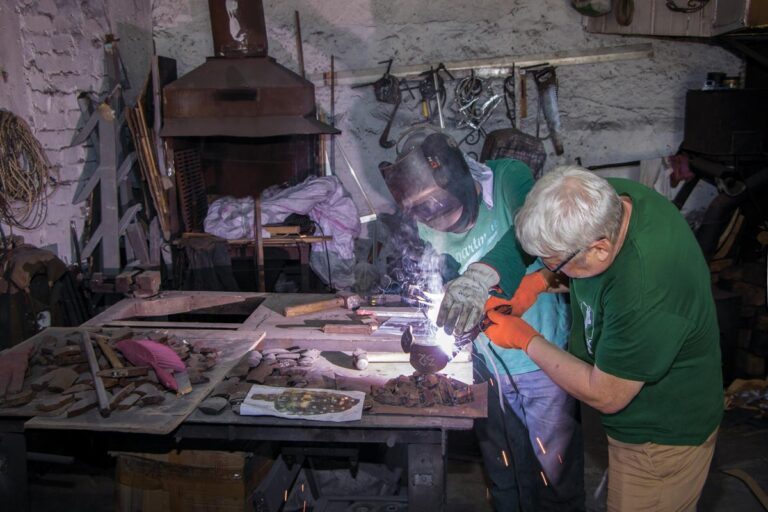
The Art of MFF | The carved elements of the mask were arranged on a mound of sand, where they were fused together using electric welding. Sergey Melnikoff (right) and Viktor Bielchyk in the workshop. Odesa, 2024.
Photo by Mariia Universaliuk
Rebirth in Metal: A Modern Interpretation
Fast forward to recent years in Ukraine, where artists have recast ancient curses into modern commentary. Ukrainian metalworker Viktor Bielchyk, collaborating with conceptual artist Sergey Melnikoff, created a stunning full‑metal replica of Itzam Kokaj Bahlam’s mask—aptly named “Mask of the War God.”
Using fragments of decommissioned combat mines, Bielchyk meticulously welded together dozens of jagged metal pieces on a sand mound, replicating the jade mask’s complex mosaic. The final mask perches atop a base of twisted shrapnel, evoking the chaos and destruction from war.
This transformation carries deep symbolism: where once chaos lay buried in ancient pyramids, here the chaos of modern warfare is molded into a new form—art. The piece critiques both the glorification of war and the human cost, reflecting wartime Ukraine’s resilience and creative regeneration.
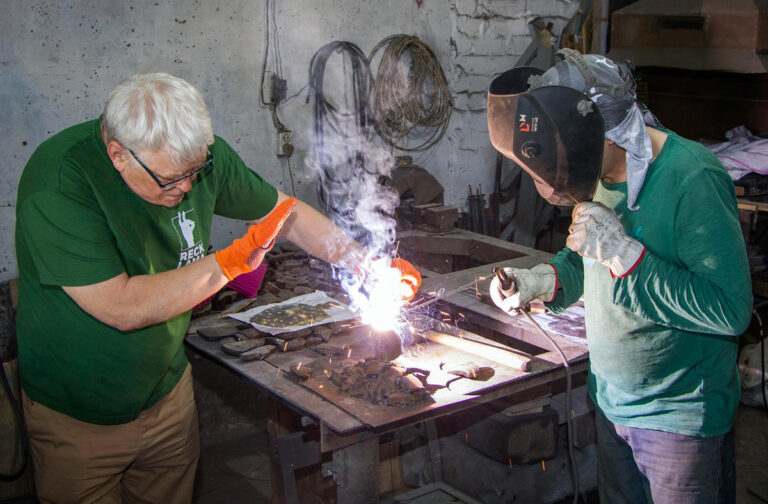
The Art of MFF | Mask of The War God. The process of creating.
Photo by Mariia Universaliuk
Auction and Cultural Resonance
The Soul of Ukraine Foundation, Inc. recently auctioned this powerful work for $47,000 USD, raising funds for humanitarian and artistic initiatives. The sale underscores how war remains central to Ukraine’s national pathos—and how art, even made from fragments of destruction, can channel collective grief into hope.
By reimagining a pre‑colonial deity in contemporary materials and context, the mask bridges ancient spirituality and modern conflict. It reconnects centuries-old ritual with 21st‑century struggles—anchoring it deeply in Ukrainian identity while speaking to universal themes of power, loss, and renewal.
Why It Matters
| Aspect | Significance |
|---|
| Historical Continuity | Revives Maya cultural memory through modern reinterpretation. |
| Material Juxtaposition | Jade becomes mine‑steel: from ceremonial reverence to war critique. |
| Political Symbolism | Reflects on power networks—ancient (Maya vassals) and contemporary (Ukraine’s defense). |
| Healing through Art | Converts instruments of violence into powerful instruments of empathy and fundraising. |
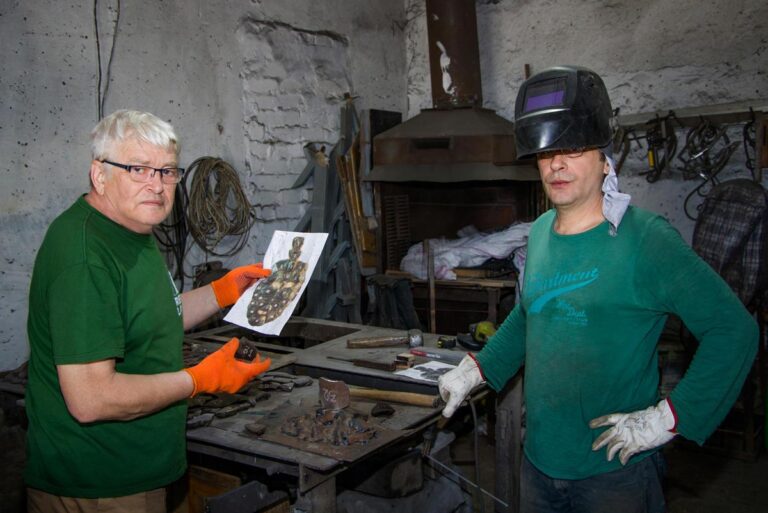
The Art of MFF | The sculpted fragments of the mask were carefully positioned on a bed of sand, then joined using electric welding. Sergey Melnikoff (left) and Viktor Bielchyk pictured in their Odesa workshop, 2024.
Photo by Mariia Universaliuk
Final Thoughts
“Mask of the War God: Itzam Kokaj Bahlam” masterfully merges ancient myth and modern reality. Its jade archetype echoed Maya royal power and spirituality; its Ukrainian alter‑ego sculpts the moral and emotional weight of war into an evocative statement of defiance and regeneration. The $47,000 auction not only affirms its artistic strength, but converts its powerful symbolism into real-world impact.
Mask of The War God
Sold for USD 47,000
Mask of Itzam Kokaj Bahlam
A magnificent jade face mask was discovered in 2021 in a royal Maya tomb at the Chochkitam site near Petén in northeastern Guatemala. Dated to approximately 350 AD, the mask is made of jade stones and belonged to the local king Itzam Kokaj Bahlam.
A metal replica of the mask by Sergey Melnikoff is made from polished shrapnel fragments collected in 2024 from the fields of Ukraine, the site of battles with Russian invaders.

